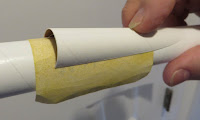The upcoming F-104 Starfighter kit from Odd'l Rockets had some interesting kit design challenges. One is the intakes on each side of the body.
The old Centuri kit folded card stock rectangles. They didn't look like the round intakes on the real jet.

I wish I could say the intake shape was developed using some complex geometry. I took the easy way out - I guessed.
Some BT-20 tube was cut into half wedge shapes. This picture shows how many tries it took to get the best fit.

Final shaping is done by sanding the rough cut edges with 220 grit wrapped around the BT-50H body tube.

Okay, here's a good fit!
To make a paper cutting pattern I could just wrap a paper around this intake and trace, but I wanted something more accurate.
More in next post -


Haven't even started my F-16 and now one of my all-time favorite jet fighter style rockets is about to make a come back! The build pile just keeps growing...
ReplyDeleteAnother great kit I will eagerly be awaiting the release of!
ReplyDeleteHi Moontana,
DeleteI'm already ordering parts for the F-104 kit. A few more test flights, instructions and tweaks and it'll be ready.
Just a FYI -- A textbook on drafting or mechanical drawing could be useful -- in particular the section covering developments. Should find some potentially useful information for dealing with things like: oblique cones (such as those found on some strap-on boosters), intersections of different shapes, transition sections (even stuff like the one on the Nike-Hercules), etc. Also comes in handy for figuring out how to make "aeroshroud" like the Centuri X-24 Bug, Centuri Vulcan, Quest DC-Y, Quest HL-20, Quest X-30...
ReplyDeleteThere were a few articles from the Apogee Newsletter that covered some of the material.
Hi Naoto,
DeleteSome advanced mechanical drawing could help with something like this. I've done plenty of drawing and some drafting for printers in the past. I hope to get into some 3D work in the future.
But, I have to look at this realistically. For instance, I won't buy software if I'll only use it once or rarely. Sometimes I learn more by doing it old school, by trial and error.
The techniques to which I was referring to pre-date use of the digital electronic computer -- using relatively simple tools such as pencil, paper, ruler, and compass. The articles in the Apogee newsletter applied the same base concepts but used computer software to aid in the drawing.
DeleteThe trial-and-error technique you used is perfectly acceptable as it would've been the easiest and quickest method for the given shape.
https://en.wikisource.org/wiki/Page:Sheet_Metal_Drafting.djvu/5
ReplyDelete